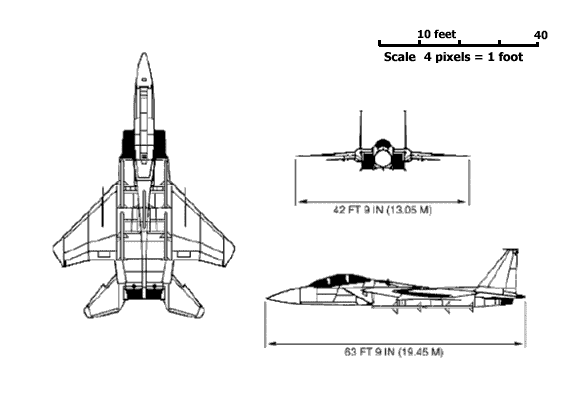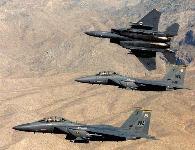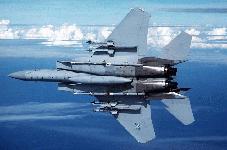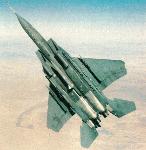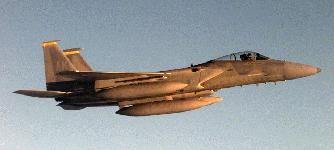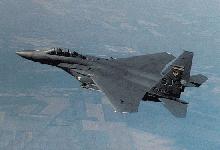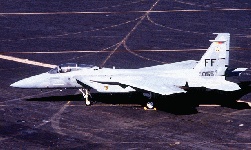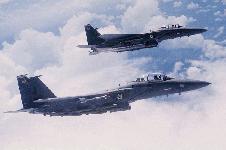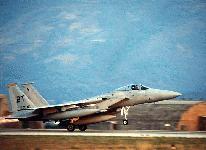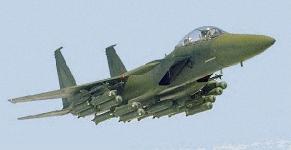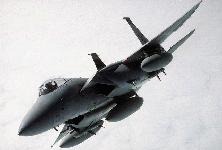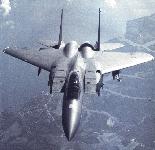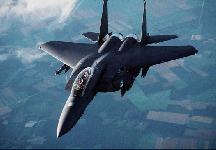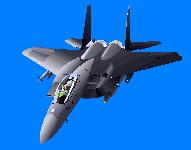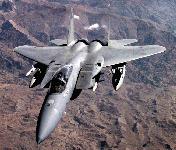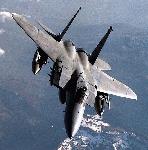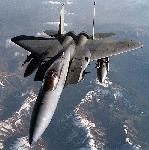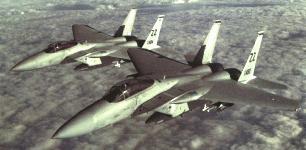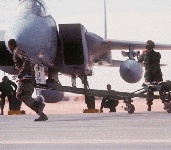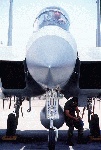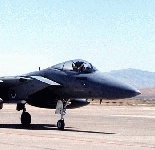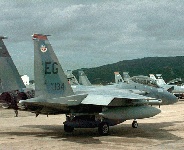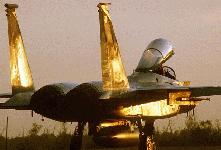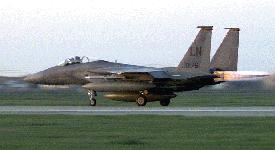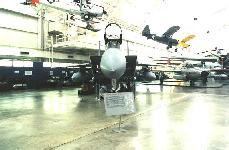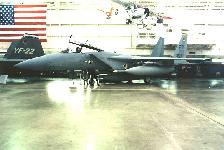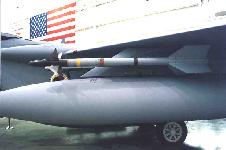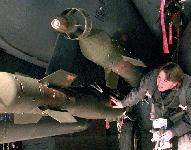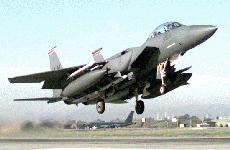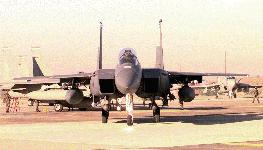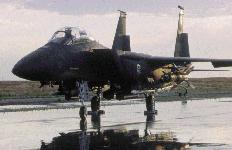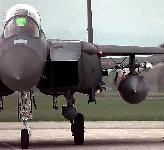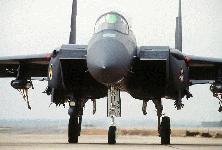



The F-15 Eagle is an all-weather, extremely maneuverable, tactical fighter designed to gain and maintain air superiority in aerial combat. The Eagle's air superiority is achieved through a mixture of maneuverability and acceleration, range, weapons and avionics. The F-15 has electronic systems and weaponry to detect, acquire, track and attack enemy aircraft while operating in friendly or enemy-controlled airspace. Its weapons and flight control systems are designed so one person can safely and effectively perform air-to-air combat. It can penetrate enemy defense and outperform and outfight current or projected enemy aircraft.
The F-15's superior maneuverability and acceleration are achieved through high engine thrust-to-weight ratio and low wing loading. Low wing-loading (the ratio of aircraft weight to its wing area) is a vital factor in maneuverability and, combined with the high thrust-to-weight ratio, enables the aircraft to turn tightly without losing airspeed.
A multimission avionics system sets the F-15 apart from other fighter aircraft. It includes a head-up display, advanced radar, inertial navigation system, flight instruments, UHF communications, tactical navigation system and instrument landing system. It also has an internally mounted, tactical electronic-warfare system, "identification friend or foe" system, electronic countermeasures set and a central digital computer.
Through an on-going multistage improvement program the F-15 is receiving extensive upgrade involving the installation or modification of new and existing avionics equipment to enhance the tactical capabilities of the F-15.
The head-up display projects on the windscreen all essential flight information gathered by the integrated avionics system. This display, visible in any light condition, provides the pilot information necessary to track and destroy an enemy aircraft without having to look down at cockpit instruments.
The F-15's versatile pulse-Doppler radar system can look up at high-flying targets and down at low-flying targets without being confused by ground clutter. It can detect and track aircraft and small high-speed targets at distances beyond visual range down to close range, and at altitudes down to tree-top level. The radar feeds target information into the central computer for effective weapons delivery. For close-in dog fights, the radar automatically acquires enemy aircraft, and this information is projected on the head-up display.
The APG-63 radar was developed over 20 years ago and has an average mean time between failure less than 15 hours. APG-63 LRUs have become increasingly difficult to support both in the field and at the depot. First, individual parts have become increasingly unavailable from any source; incorporating newer technology parts often entails module redesign and fails to address the root cause. Second, continuing reliability deterioration impacts both sustainment, particularly during deployment, as well as ACC�s ability to implement two-level maintenance. In addition, the APG-63 radar has virtually no remaining processing and memory capacity to accommodate software upgrades to counter evolving threats. The APG-63(V)1 radar has been designed for improved reliability and maintainability to address user requirements. The radar incorporates components designed for improved reliability and lower failure rates and enhanced diagnostics for improved fault detection and fault isolation. Along with other design features, these should improve radar reliability to 120 hours MTBM, an order of magnitude better than the existing APG-63.An inertial navigation system enables the Eagle to navigate anywhere in the world. It gives aircraft position at all times as well as pitch, roll, heading, acceleration and speed information.
The F-15's electronic warfare system provides both threat warning and automatic countermeasures against selected threats. The "identification friend or foe" system informs the pilot if an aircraft seen visually or on radar is friendly. It also informs U.S. or allied ground stations and other suitably equipped aircraft that the F-15 is a friendly aircraft.
The Fiber Optic Towed Decoy (FOTD) provides aircraft protection against modern radar-guided missiles to supplement traditional radar jamming equipment. The device is towed at varying distances behind the aircraft while transmitting a signal like that of a threat radar. The missile will detect and lock onto the decoy rather than on the aircraft. This is achieved by making the decoy�s radiated signal stronger than that of the aircraft.A variety of air-to-air weaponry can be carried by the F-15. An automated weapon system enables the pilot to perform aerial combat safely and effectively, using the head-up display and the avionics and weapons controls located on the engine throttles or control stick. When the pilot changes from one weapon system to another, visual guidance for the required weapon automatically appears on the head-up display.
The Eagle can be armed with combinations of four different air-to-air weapons: AIM-7F/M Sparrow missiles or AIM-120 Advanced Medium Range Air-to-Air Missiles on its lower fuselage corners, AIM-9L/M Sidewinder or AIM-120 missiles on two pylons under the wings, and an internal 20mm Gatling gun (with 940 rounds of ammunition) in the right wing root.
The current AIM-9 missile does not have the capabilities demonstrated by foreign technologies, giving the F-15 a distinct disadvantage during IR dogfight scenarios. AIM-9X integration will once again put the F-15 in the air superiority position in all arenas. The F-15/AIM-9X weapon system is to consist of F-15 carriage of the AIM-9X missile on a LAU-128 Air-to-Air (A/A) launcher from existing AIM-9 certified stations. The AIM-9X will be an upgrade to the AIM-9L/M, incorporating increased missile maneuverability and allowing a high off-boresight targeting capability.Low-drag, conformal fuel tanks were especially developed for the F-15C and D models. Conformal fuel tanks can be attached to the sides of the engine air intake trunks under each wing and are designed to the same load factors and airspeed limits as the basic aircraft. Each conformal fuel tank contains about 114 cubic feet of usable space. These tanks reduce the need for in-flight refueling on global missions and increase time in the combat area. All external stations for munitions remain available with the tanks in use. AIM-7F/M Sparrow and AIM-120 missiles, moreover, can be attached to the corners of the conformal fuel tanks.
The F-15 Eagle began its life in the mid 1960s as the Fighter Experimental (FX) concept. Using lessons learned in Vietnam, the USAF sought to develop and procure a new, dedicated air superiority fighter. Such an aircraft was desperately needed, as no USAF aircraft design solely conceived as an air superiority fighter had become reality since the F-86 Sabre. The intervening twenty years saw a number of aircraft performing the air-to-air role as a small part of their overall mission, such as the primarily air-to-ground F-4 Phantom and the F-102, F-104 and F-106 interceptor designs. The result of the FX study was a requirement for a fighter design combining unparalleled maneuverability with state-of-the-art avionics and weaponry. An industry-wide competition ended on December 23, 1969 when McDonnell Douglas was awarded the contract for the F-15.

F-15C's, D's and E's were deployed to the Persian Gulf in 1991 in support of Operation Desert Storm where they proved their superior combat capability with a confirmed 26:0 kill ratio.
The F-15C has an air combat victory ratio of 95-0 making it one of the most effective air superiority aircraft ever developed. The US Air Force claims the F-15C is in several respects inferior to, or at best equal to, the MiG-29, Su-27, Su-35/37, Rafale, and EF-2000, which are variously superior in acceleration, maneuverability, engine thrust, rate of climb, avionics, firepower, radar signature, or range. Although the F-15C and Su-27P series are similar in many categories, the Su-27 can outperform the F-15C at both long and short ranges. In long-range encounters, with its superiorr radar the Su-27 can launch a missile before the F-15C does, so from a purely kinematic standpoint, the Russian fighters outperform the F-15C in the beyond-visual-range fight. The Su-35 phased array radar is superior to the APG-63 Doppler radar in both detection range and tracking capabilities. Additionally, the Su-35 propulsion system increases the aircraft�s maneuverability with thrust vectoring nozzles. Simulations conducted by British Aerospace and the British Defense Research Agency compared the effectiveness of the F-15C, Rafale, EF-2000, and F-22 against the Russian Su-35 armed with active radar missiles similar to the AIM-120 Advanced Medium Range Air-to-Air Missile (AMRAAM). The Rafale achieved a 1:1 kill ratio (1 Su-35 destroyed for each Rafale lost). The EF-2000 kill ratio was 4.5:1 while the F-22 achieved a ratio of 10:1. In stark contrast was the F-15C, losing 1.3 Eagles for each Su-35 destroyed.
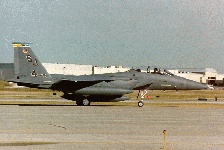 Although the slogan of the F-15's
original design team was "Not a pound for air-to-ground," the F-15 has
long been recognized as having superior potential in the ground attack
role. In 1987 this potential was realized in the form of the F-15E
Strike Eagle. The mission of the Strike Eagle is as succinct as that
of its air-to-air cousin: to put bombs on target. The F-15E is
especially configured for the deep strike mission, venturing far
behind enemy lines to attack high value targets with a variety of
munitions. The Strike Eagle accomplishes this mission by expanding on
the capabilities of the air superiority F-15, adding a rear seat WSO
(Weapon Systems Operator) crewmember and incorporating an entirely new
suite of air-to-ground avionics.
Although the slogan of the F-15's
original design team was "Not a pound for air-to-ground," the F-15 has
long been recognized as having superior potential in the ground attack
role. In 1987 this potential was realized in the form of the F-15E
Strike Eagle. The mission of the Strike Eagle is as succinct as that
of its air-to-air cousin: to put bombs on target. The F-15E is
especially configured for the deep strike mission, venturing far
behind enemy lines to attack high value targets with a variety of
munitions. The Strike Eagle accomplishes this mission by expanding on
the capabilities of the air superiority F-15, adding a rear seat WSO
(Weapon Systems Operator) crewmember and incorporating an entirely new
suite of air-to-ground avionics.
The F-15E is a two seat, two engine dual role fighter capable of speeds up to MACH 2.5. The F-15E performs day and night all weather air-to-air and air-to-ground missions including strategic strike, interdiction, OCA and DCA. Although primarily a deep interdiction platform, the F-15E can also perform CAS and Escort missions. Strike Eagles are equipped with LANTIRN, enhancing night PGM delivery capability. The F-15E outbord and inboard wing stations and the centerline can be load with various armament. The outboard wing hardpoint are unable to carry heavy loads and are assign for ECM pods. The other hardpoints can be employed for various loads but with the use of multiple ejection racks (MERs). Each MER can hold six Mk-82 bombs or "Snakeye" retarded bombs, or six Mk 20 "Rockeye" dispensers, four CBU-52B, CBU- 58B, or CBU-71B dispensers, a single Mk-84 (907 kg) bomb F- 15E can carry also "smart" weapons, CBU-10 laser quided bomb based on the Mk 84 bomb, CBU-12, CBU-15, or another, laser, electro-optical, or infra-red guided bomb (including AGM-G5 "Marerick" air-to-ground) missiles.
Conformal Fuel Tanks were introduced with the F-15C in order to extend the range of the aircraft. The CFTs are carried in pairs and fit closely to the side of the aircraft, with one CFT underneath each wing. By designing the CFT to minimize the effect on aircraft aerodynamics, much lower drag results than if a similar amount of fuel is carried in conventional external fuel tanks. This lower drag translate directly into longer aircraft ranges, a particularly desirable characteristic of a deep strike fighter like the F-15E. As with any system, the use of CFTs on F-15s involves some compromise. The weight and drag of the CFTs (even when empty) degrades aircraft performance when compared to external fuel tanks, which can be jettisoned when needed (CFTs are not jettisonable and can only be downloaded by maintenance crews). As a result, CFTs are typically used in situations where increased range offsets any performance drawbacks. In the case of the F-15E, CFTs allow air-to-ground munitions to be loaded on stations which would otherwise carry external fuel tanks. In general, CFT usage is the norm for F15Es and the exception for F-15C/D's.
The F-15E Strike Eagle�s tactical electronic warfare system [TEWS] is an integrated countermeasures system. Radar, radar jammer, warning receiver and chaff/flare dispenser all work together to detect, identify and counter threats posed by an enemy. For example, if the warning receiver detects a threat before the radar jammer, the warning receiver will inform the jammer of the threat. A Strike Eagle�s TEWS can jam radar systems operating in high frequencies, such as radar used by short-range surface-to-air missiles, antiaircraft artillery and airborne threats. Current improvements to TEWS will enhance the aircraft�s ability to jam enemy radar systems. The addition of new hardware and software, known as Band 1.5, will round out the TEWS capability by jamming threats in mid-to-low frequencies, such as long-range radar systems. The equipment is expected to go into full production sometime in late 1999.
The Defense Department plans to sustain production of the F-15E for at least two more years, purchasing three aircraft in both FY 1998 and FY 1999. Without FY 1998 procurement, the F-15 production line would begin to close in the absence of new foreign sales. These six additional aircraft, together with the six aircraft approved by Congress in FY 1997, will sustain the present 132-plane combat force structure until about FY 2016. Under current plans by 2030, the last F-15C/D models will have been phased out of the inventory and replaced by the F-22.
The F-15 initial operational requirement was for a service life of 4,000 hours. Testing completed in 1973 demonstrated that the F-15 could sustain 16,000 hours of flight. Subsequently operational use was more severely stressful than the original design specification. With an average usage of 270 aircraft flight hours per year, by the early 1990s the F-15C fleet was approaching its service-design-life limit of 4,000 flight hours. Following successful airframe structural testing, the F-15C was extended to an 8,000-hour service life limit. An 8,000-hour service limit provides current levels of F-15Cs through 2010. The F-22 program was initially justified on the basis of an 8,000 flight hour life projection for the F-15. This was consistent with the projected lifespan of the most severely stressed F-15Cs, which have averaged 85% of flight hours in stressful air-to-air missions, versus the 48% in the original design specification.
Full-scale fatigue testing between 1988 and 1994 ended with a demonstration of over 7,600 flight hours for the most severely used aircraft, and in excess of 12,000 hours on the remainder of the fleet. A 10,000-hour service limit would provide F-15Cs to 2020, while a 12,000-hour service life extends the F-15Cs to the year 2030. The APG-63 radar, F100-PW-100 engines, and structure upgrades are mandatory. The USAF cannot expect to fly the F-15C to 2014, or beyond, without replacing these subsystems. The total cost of the three retrofits would be under $3 billion. The upgrades would dramatically reduce the 18 percent breakrate prevalent in the mid-1990s, and extend the F-15C service life well beyond 2014.
The F-15E structure is rated at 16,000 flight hours, double the lifetime of earlier F-15s.
The Eagle has been chosen by three foreign military customers to modernize their air forces. Japan has purchased and produces an air-to-air F-15 known as the F-15J. Israel has bought F-15A, B, and D aircraft from USAF inventories and is currently obtaining an air-to-ground version called the F-15I. Similarly, Saudi Arabia has purchased F-15C and D aircraft and acquired the air-to-ground F-15S.
F-15 production has been extended into 1999 by orders for 72 F-15S aircraft for Saudi Arabia. Peace Sun IX is an F-15 Foreign Military Sales production program, with development, to deliver 72 F-15S aircraft including support equipment, spares, and training to the Royal Saudi government. Saudi Arabia has purchased a total of 62 F-15C and D aircraft and later procured the F-15S, which is a two-seater aircraft based on the F-15E airframe, with downgraded avionics, downgraded LANTIRN pods, and a simplified Hughes APG-70 radar without computerised radar mapping. Four F-15S Eagles were delivered in 1995. On 10 November 1999 the last of 72 F-15S aircraft was delivered to Saudi Arabia. In November 1995 Saudi Arabia purchased 556 GBU-15 Guided Bomb Units (including six training units), 48 data link pods, personnel training and training equipment and other related elements of logistics support. The estimated cost is $371 million. Saudi Arabia would use the GBU-15s to enhance the stand off attack capability of the F-15S aircraft.
Specifications | |||||||||||||||||||||||||||||||||||||||||||||||||||||||||||||||||||||||||||||||||||||||||||||||||||||||||||||||||||||||||||||||||||||||||||||||||||||||||||||||||||||||||||||||||||||||||||||||||||||||||||||||||||||||||||||||
| Primary Function | Tactical fighter. | ||||||||||||||||||||||||||||||||||||||||||||||||||||||||||||||||||||||||||||||||||||||||||||||||||||||||||||||||||||||||||||||||||||||||||||||||||||||||||||||||||||||||||||||||||||||||||||||||||||||||||||||||||||||||||||||
| Contractor | McDonnell Douglas Corp. | ||||||||||||||||||||||||||||||||||||||||||||||||||||||||||||||||||||||||||||||||||||||||||||||||||||||||||||||||||||||||||||||||||||||||||||||||||||||||||||||||||||||||||||||||||||||||||||||||||||||||||||||||||||||||||||||
| Power Plant | Two Pratt & Whitney F100-PW-100 turbofan engines with afterburners. | ||||||||||||||||||||||||||||||||||||||||||||||||||||||||||||||||||||||||||||||||||||||||||||||||||||||||||||||||||||||||||||||||||||||||||||||||||||||||||||||||||||||||||||||||||||||||||||||||||||||||||||||||||||||||||||||
| Thrust | (C/D models) 25,000 pounds each engine ( 11,250 kilograms). | ||||||||||||||||||||||||||||||||||||||||||||||||||||||||||||||||||||||||||||||||||||||||||||||||||||||||||||||||||||||||||||||||||||||||||||||||||||||||||||||||||||||||||||||||||||||||||||||||||||||||||||||||||||||||||||||
| Length | 63 feet, 9 inches (19.43 meters). | ||||||||||||||||||||||||||||||||||||||||||||||||||||||||||||||||||||||||||||||||||||||||||||||||||||||||||||||||||||||||||||||||||||||||||||||||||||||||||||||||||||||||||||||||||||||||||||||||||||||||||||||||||||||||||||||
| Height | 18 feet, 8 inches (5.69 meters). | ||||||||||||||||||||||||||||||||||||||||||||||||||||||||||||||||||||||||||||||||||||||||||||||||||||||||||||||||||||||||||||||||||||||||||||||||||||||||||||||||||||||||||||||||||||||||||||||||||||||||||||||||||||||||||||||
| Wingspan | 42 feet, 10 inches (13.06 meters) | ||||||||||||||||||||||||||||||||||||||||||||||||||||||||||||||||||||||||||||||||||||||||||||||||||||||||||||||||||||||||||||||||||||||||||||||||||||||||||||||||||||||||||||||||||||||||||||||||||||||||||||||||||||||||||||||
| Speed | 1,875 mph (Mach 2.5-plus at sea level). | ||||||||||||||||||||||||||||||||||||||||||||||||||||||||||||||||||||||||||||||||||||||||||||||||||||||||||||||||||||||||||||||||||||||||||||||||||||||||||||||||||||||||||||||||||||||||||||||||||||||||||||||||||||||||||||||
| Ceiling | 65,000 feet (19,697 meters). | ||||||||||||||||||||||||||||||||||||||||||||||||||||||||||||||||||||||||||||||||||||||||||||||||||||||||||||||||||||||||||||||||||||||||||||||||||||||||||||||||||||||||||||||||||||||||||||||||||||||||||||||||||||||||||||||
| Maximum Takeoff Weight | (C/D models) 68,000 pounds (30,600 kilograms). | ||||||||||||||||||||||||||||||||||||||||||||||||||||||||||||||||||||||||||||||||||||||||||||||||||||||||||||||||||||||||||||||||||||||||||||||||||||||||||||||||||||||||||||||||||||||||||||||||||||||||||||||||||||||||||||||
| Range | 3,450 miles (3,000 nautical miles) ferry range with conformal fuel tanks and three external fuel tanks. | ||||||||||||||||||||||||||||||||||||||||||||||||||||||||||||||||||||||||||||||||||||||||||||||||||||||||||||||||||||||||||||||||||||||||||||||||||||||||||||||||||||||||||||||||||||||||||||||||||||||||||||||||||||||||||||||
| Armament | 1 - M-61A1 20mm multibarrel internal gun, 940 rounds of ammunition 4 - AIM-9L/M Sidewinder and 4 - AIM-7F/M Sparrow missiles, or combination of AIM-9L/M, AIM-7-F/M and AIM-120 missiles. F-15C Weapon Loads
F-15E Weapon Loads12 CBU-52 (6 with wing tanks)12 CBU-59 (6 with wing tanks) 12 CBU-71 (6 with wing tanks) 12 CBU-87 (6 with wing tanks) 12 CBU-89 (6 with wing tanks) 20 MK-20 (6 with wing tanks)
| ||||||||||||||||||||||||||||||||||||||||||||||||||||||||||||||||||||||||||||||||||||||||||||||||||||||||||||||||||||||||||||||||||||||||||||||||||||||||||||||||||||||||||||||||||||||||||||||||||||||||||||||||||||||||||||||
| Systems |
[ on F-15E, F-15C/D, F-15A/B MSIP] | ||||||||||||||||||||||||||||||||||||||||||||||||||||||||||||||||||||||||||||||||||||||||||||||||||||||||||||||||||||||||||||||||||||||||||||||||||||||||||||||||||||||||||||||||||||||||||||||||||||||||||||||||||||||||||||||
| Crew | F-15A/C: one. F-15B/D: two. | ||||||||||||||||||||||||||||||||||||||||||||||||||||||||||||||||||||||||||||||||||||||||||||||||||||||||||||||||||||||||||||||||||||||||||||||||||||||||||||||||||||||||||||||||||||||||||||||||||||||||||||||||||||||||||||||
| Unit cost $FY98 [Total Program] | $43 million. | ||||||||||||||||||||||||||||||||||||||||||||||||||||||||||||||||||||||||||||||||||||||||||||||||||||||||||||||||||||||||||||||||||||||||||||||||||||||||||||||||||||||||||||||||||||||||||||||||||||||||||||||||||||||||||||||
| Date Deployed | July 1972 | ||||||||||||||||||||||||||||||||||||||||||||||||||||||||||||||||||||||||||||||||||||||||||||||||||||||||||||||||||||||||||||||||||||||||||||||||||||||||||||||||||||||||||||||||||||||||||||||||||||||||||||||||||||||||||||||
| Production [for USAF] |
360 F-15A/B 408 F-15C 61 F-15D 203 F-15E | ||||||||||||||||||||||||||||||||||||||||||||||||||||||||||||||||||||||||||||||||||||||||||||||||||||||||||||||||||||||||||||||||||||||||||||||||||||||||||||||||||||||||||||||||||||||||||||||||||||||||||||||||||||||||||||||
| Total Inventory |
275 F-15A/B 410 F-15C/D 203 F-15E Approximately 100 F-15s are in storage @ AMARC | ||||||||||||||||||||||||||||||||||||||||||||||||||||||||||||||||||||||||||||||||||||||||||||||||||||||||||||||||||||||||||||||||||||||||||||||||||||||||||||||||||||||||||||||||||||||||||||||||||||||||||||||||||||||||||||||
|
PMAI Primary Mission Aircraft Inventory |
45 F-15A/B Air National Guard Air Defense Force 45 F-15A/B Air National Guard 126 F-15C/D Air Combat Command 90 F-15C/D Pacific Air Forces 36 F-15C/D US Air Forces Europe 342 F-15A/C TOTAL 66 F-15E Air Combat Command 18 F-15E Pacific Air Forces 48 F-15E US Air Forces Europe 132 F-15E TOTAL Only combat-coded aircraft and not development/ test, attrition reserve, depot maintenance, or training aircraft. | ||||||||||||||||||||||||||||||||||||||||||||||||||||||||||||||||||||||||||||||||||||||||||||||||||||||||||||||||||||||||||||||||||||||||||||||||||||||||||||||||||||||||||||||||||||||||||||||||||||||||||||||||||||||||||||||

| VRML 3-D Model | |
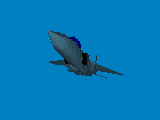 F-15 Eagle VRML by Soji Yamakawa |
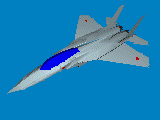 F-15J EAGLE VRML by Soji Yamakawa |
